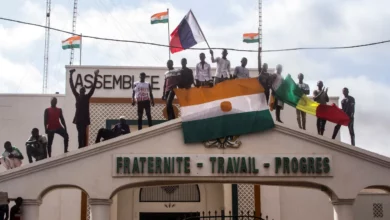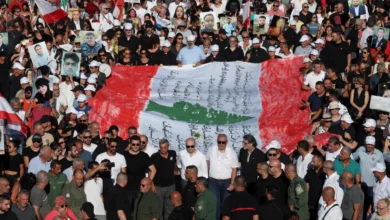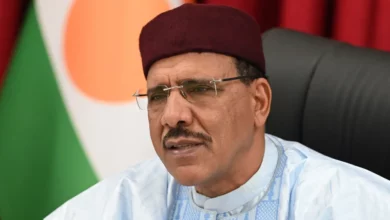Three developments top the news Wednesday in Egypt’s papers, including the massive anti-Morsy protests that flooded the presidential palace in Heliopolis on Tuesday, the ongoing constitutional crisis, and media strikes against the new constitution.
The headlines of the independent Youm7, Al-Shorouk, and Al-Sabah newspapers all run identical headlines: “Presidential palace under siege.” These papers report that Tuesday’s marches and rallies, dubbed “The final warning,” involved tens of thousands of demonstrators who converged on the Ittihadiya Palace in Heliopolis to protest against Presidents Mohamed Morsy’s controversial constitutional decree of 22 November and an equally controversial draft constitution which is set to be voted on in a referendum scheduled for 15 December.
Youm7 refers to “massive protests in Cairo and Alexandria against the constitutional declaration and referendum.” The article reports that journalists launched a march from the Journalists Syndicate to Tahrir Square, while other marches took off from the square in the direction of the presidential palace. “Masses in Alexandria wear black clothes to protest and mourn the loss of the state of law,” the independent daily also reports. This paper notes that hundreds of thousands took part in protests outside the Ittihadiya Palace, in Tahrir Square, in Alexandria and in other governorates on Tuesday.
The top headline in the independent Al-Tahrir Newspaper is, “Barbed wire and tanks protect Morsy from his own population.” However, these “tanks” — stationed within the gates of the palace — were actually armored personnel carriers bearing the insignia of the Republican Guard, not military tanks.
Al-Shorouk reports that anti-Morsi protests also took place in Suez, Kafr al-Sheikh, Qalyubiya and New Valley Governorates. The privately-owned paper adds that delegations from these governorates joined in the protests outside the presidential palace. Al-Shorouk also notes that the Interior Ministry and Republican Guard had turned the Ittihadiya Palace into a “military barracks,” with barbed-wired fences and heavy security presence both inside and outside the palace.
The state-owned Al-Akhbar leads with, “Heliopolis is a military barracks… Clashes around the presidential palace.” The state-owned headline also runs an article entitled, “Massive protests demand retraction of constitutional declaration and Constituent Assembly,” which says that “hundreds of thousands participated in Tuesday’s rallies and marches, which included a high participation of women.” The piece reports that hundreds of women participated in a march around downtown Cairo which was organized by the Egyptian Democratic Labor Congress.
Al-Akhbar runs other headlines reading, “Security forces clash with protesters attempting to breach fences” and “Protesters fire flares, security forces respond with tear-gas.” The articles do not delve into great detail about this incident.
Yet on Tuesday night, thousands of angry protesters did not only attempt to breach barbed wire fences, but actually succeeded in doing so and in pushing back riot police forces after the troops fired tear gas. Three fences were dismantled during Tuesday’s protests.
According to the Muslim Brotherhood’s mouthpiece, the Freedom and Justice Newspaper, “only a few hundred protesters” converged on the presidential palace on Tuesday. While all Egyptian newspapers carry photos of massive throngs of angry protesters around the Ittihadiya Palace, the Brotherhood’s paper runs one photo — clearly taken before the start of the 5 pm protest marches — which shows no more than two dozen people assembled near Morsy’s palace. None of the protesters in this photo are carrying signs or banners; only one person is carrying an Egyptian flag.
This article reports that “some members of this protest were paid money to cause violence and chaos.” The partisan paper goes on to explain how “the services of thugs and groups with criminal records were used in this protest. The thugs were rented from [Cairo’s] districts of Waiyli, Abbasseya, Zawiya al-Hamra, and Bab al-Shaariya.”
The same article mentions that the prosecutor general is investigating charges against Naguib Sawaris (a Coptic Christian, telecom tycoon, and financier of the liberal Free Egyptians Party) “on charges of instigating a military coup, instigating sectarian strife, and causing national instability.”
In other news, the Freedom and Justice Newspaper focuses much of its coverage on the draft constitution, which was written by a Constituent Assembly dominated by the Brotherhood and other Islamist groups.
The Brotherhood paper includes an 8 page copy of the draft constitution with its 236 articles, which it refers to as “the Constitution of the Revolution.” This pamphlet bears on its cover the photo of the bearded president and the bearded head of the Constituent Assembly, Hossam al-Gheriany, holding a copy of the new constitution.
In other articles, Freedom and Justice argues that, “The constitution champions the rights of the poor and marginalized communities” along with “adequate pensions for small farmers and seasonally employed laborers.”
However, the paper does not mention that the 50 percent workers and farmers’ parliamentary quota was scrapped in the constitution draft while restrictions were imposed on the right to establish professional associations, among other setbacks to Egypt’s working classes.
The Brotherhood paper also mentions that the draft constitution “protects the rights of women with dependents” although it fails to mention that an article safeguarding women’s rights was scrapped from the constitution altogether, owing to a disagreement over the rights of women according to Sharia law.
The nominally independent yet anti-Brotherhood Al-Dostour runs a headline warning: “If this Brotherhood constitution passes in a referendum then everything is finished… We will not be able to object and Egypt will be turned into a new Afghan State within six months at the most.”
In other news, a media blackout protest has entered its second day. According to Al-Shorouk and Al-Sabah, 11 newspapers — both independent and opposition publications — went on strike Tuesday in protest against Morsy’s constitutional declaration and a hastily prepared draft constitution.
Al-Shorouk mentions that newspaper vendors were negatively affected by this protest, with some vendors reporting lost revenues amounting up to 80 percent of sales. Vendors reported “large piles of unsold state-owned papers,” the state-owned paper said.
The Brotherhood paper covers this issue with a front-page headline reading, “Businessmen affiliated to the deposed leader [Hosni Mubarak] lead press blackout.” This paper adds, “Tuesday was a good day for Egypt’s newspaper readers, while it was a black day for the owners of these papers.”
Al-Sabah newspaper mentions that an (unspecified) number of newspaper editors are refusing to convene a meeting scheduled today with the Ahmed Fahmy, speaker of the Shura Council and head of the Supreme Press Council, who is a Brotherhood member.
In another development, three satellite channels — Dream TV, ONTV and CBC were also planning a blackout Wednesday, Al-Sabah reports. The independent daily lists “dictatorship” and “tyrannical decrees” as the reason behind their blackouts.




